Economics for Business - Assignment: Elasticity and Monopoly Power
VerifiedAdded on 2023/01/18
|15
|3950
|84
Homework Assignment
AI Summary
This economics assignment analyzes price elasticity estimates for milk, meat, and rice in Australia, drawing on research from 2017-2019. It examines expenditure and own-price elasticities, highlighting the impact of factors like ethnicity and substitutes. The assignment also explores the Australian Post's monopoly power, discussing its strategies, benefits, and consumer impact. It identifies how the Australian Post maintains its monopoly in the postal industry. The analysis includes how government intervention is used to curb this power and the implications of such interventions. The assignment is structured to assess the understanding of economic concepts such as price elasticity of demand and monopoly power within the context of the Australian market. The solution provides detailed insights into the economic behavior of consumers and the dynamics of market power in the Australian economy.
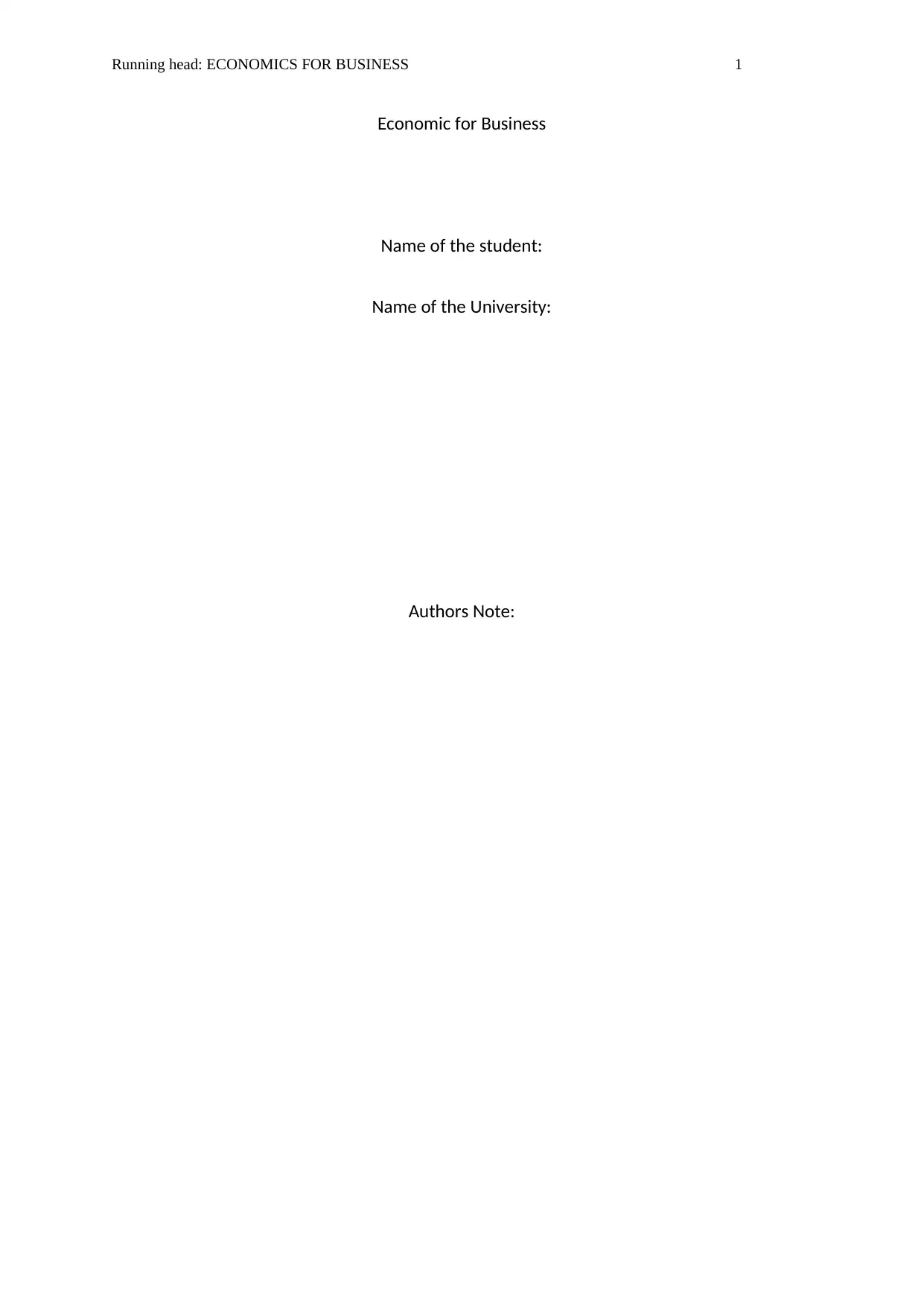
Running head: ECONOMICS FOR BUSINESS 1
Economic for Business
Name of the student:
Name of the University:
Authors Note:
Economic for Business
Name of the student:
Name of the University:
Authors Note:
Paraphrase This Document
Need a fresh take? Get an instant paraphrase of this document with our AI Paraphraser
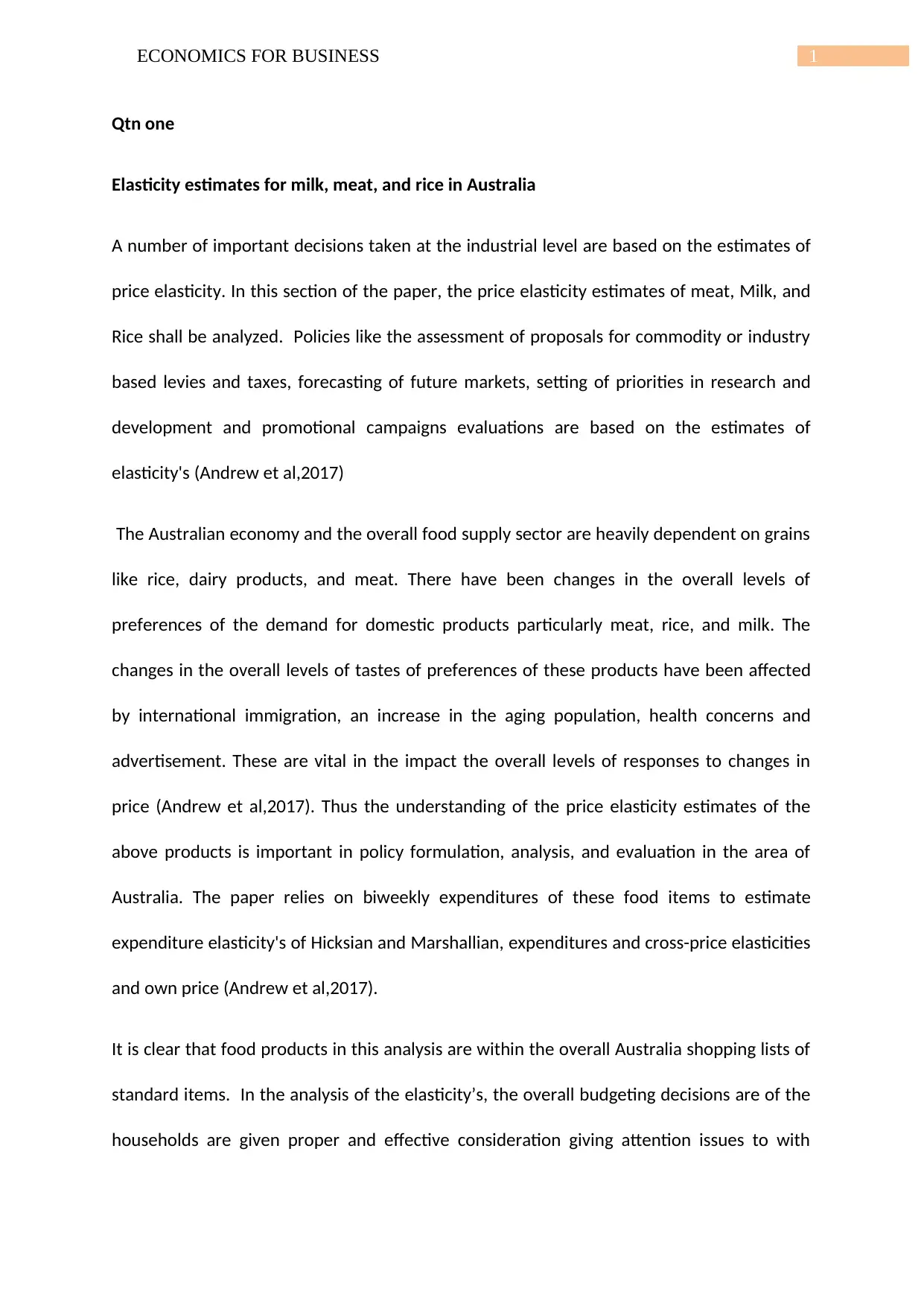
1ECONOMICS FOR BUSINESS
Qtn one
Elasticity estimates for milk, meat, and rice in Australia
A number of important decisions taken at the industrial level are based on the estimates of
price elasticity. In this section of the paper, the price elasticity estimates of meat, Milk, and
Rice shall be analyzed. Policies like the assessment of proposals for commodity or industry
based levies and taxes, forecasting of future markets, setting of priorities in research and
development and promotional campaigns evaluations are based on the estimates of
elasticity's (Andrew et al,2017)
The Australian economy and the overall food supply sector are heavily dependent on grains
like rice, dairy products, and meat. There have been changes in the overall levels of
preferences of the demand for domestic products particularly meat, rice, and milk. The
changes in the overall levels of tastes of preferences of these products have been affected
by international immigration, an increase in the aging population, health concerns and
advertisement. These are vital in the impact the overall levels of responses to changes in
price (Andrew et al,2017). Thus the understanding of the price elasticity estimates of the
above products is important in policy formulation, analysis, and evaluation in the area of
Australia. The paper relies on biweekly expenditures of these food items to estimate
expenditure elasticity's of Hicksian and Marshallian, expenditures and cross-price elasticities
and own price (Andrew et al,2017).
It is clear that food products in this analysis are within the overall Australia shopping lists of
standard items. In the analysis of the elasticity’s, the overall budgeting decisions are of the
households are given proper and effective consideration giving attention issues to with
Qtn one
Elasticity estimates for milk, meat, and rice in Australia
A number of important decisions taken at the industrial level are based on the estimates of
price elasticity. In this section of the paper, the price elasticity estimates of meat, Milk, and
Rice shall be analyzed. Policies like the assessment of proposals for commodity or industry
based levies and taxes, forecasting of future markets, setting of priorities in research and
development and promotional campaigns evaluations are based on the estimates of
elasticity's (Andrew et al,2017)
The Australian economy and the overall food supply sector are heavily dependent on grains
like rice, dairy products, and meat. There have been changes in the overall levels of
preferences of the demand for domestic products particularly meat, rice, and milk. The
changes in the overall levels of tastes of preferences of these products have been affected
by international immigration, an increase in the aging population, health concerns and
advertisement. These are vital in the impact the overall levels of responses to changes in
price (Andrew et al,2017). Thus the understanding of the price elasticity estimates of the
above products is important in policy formulation, analysis, and evaluation in the area of
Australia. The paper relies on biweekly expenditures of these food items to estimate
expenditure elasticity's of Hicksian and Marshallian, expenditures and cross-price elasticities
and own price (Andrew et al,2017).
It is clear that food products in this analysis are within the overall Australia shopping lists of
standard items. In the analysis of the elasticity’s, the overall budgeting decisions are of the
households are given proper and effective consideration giving attention issues to with
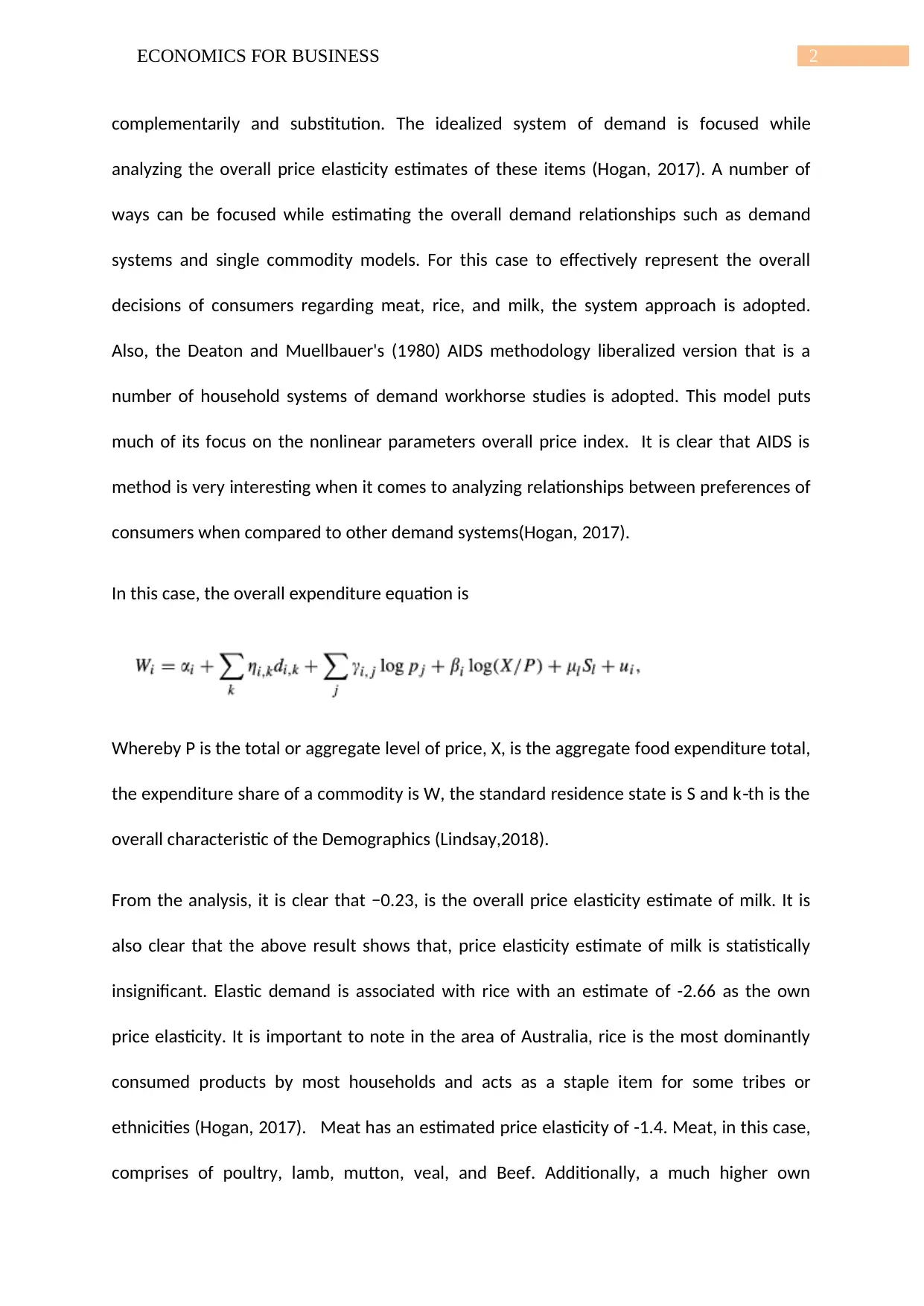
2ECONOMICS FOR BUSINESS
complementarily and substitution. The idealized system of demand is focused while
analyzing the overall price elasticity estimates of these items (Hogan, 2017). A number of
ways can be focused while estimating the overall demand relationships such as demand
systems and single commodity models. For this case to effectively represent the overall
decisions of consumers regarding meat, rice, and milk, the system approach is adopted.
Also, the Deaton and Muellbauer's (1980) AIDS methodology liberalized version that is a
number of household systems of demand workhorse studies is adopted. This model puts
much of its focus on the nonlinear parameters overall price index. It is clear that AIDS is
method is very interesting when it comes to analyzing relationships between preferences of
consumers when compared to other demand systems(Hogan, 2017).
In this case, the overall expenditure equation is
Whereby P is the total or aggregate level of price, X, is the aggregate food expenditure total,
the expenditure share of a commodity is W, the standard residence state is S and k th is the‐
overall characteristic of the Demographics (Lindsay,2018).
From the analysis, it is clear that −0.23, is the overall price elasticity estimate of milk. It is
also clear that the above result shows that, price elasticity estimate of milk is statistically
insignificant. Elastic demand is associated with rice with an estimate of -2.66 as the own
price elasticity. It is important to note in the area of Australia, rice is the most dominantly
consumed products by most households and acts as a staple item for some tribes or
ethnicities (Hogan, 2017). Meat has an estimated price elasticity of -1.4. Meat, in this case,
comprises of poultry, lamb, mutton, veal, and Beef. Additionally, a much higher own
complementarily and substitution. The idealized system of demand is focused while
analyzing the overall price elasticity estimates of these items (Hogan, 2017). A number of
ways can be focused while estimating the overall demand relationships such as demand
systems and single commodity models. For this case to effectively represent the overall
decisions of consumers regarding meat, rice, and milk, the system approach is adopted.
Also, the Deaton and Muellbauer's (1980) AIDS methodology liberalized version that is a
number of household systems of demand workhorse studies is adopted. This model puts
much of its focus on the nonlinear parameters overall price index. It is clear that AIDS is
method is very interesting when it comes to analyzing relationships between preferences of
consumers when compared to other demand systems(Hogan, 2017).
In this case, the overall expenditure equation is
Whereby P is the total or aggregate level of price, X, is the aggregate food expenditure total,
the expenditure share of a commodity is W, the standard residence state is S and k th is the‐
overall characteristic of the Demographics (Lindsay,2018).
From the analysis, it is clear that −0.23, is the overall price elasticity estimate of milk. It is
also clear that the above result shows that, price elasticity estimate of milk is statistically
insignificant. Elastic demand is associated with rice with an estimate of -2.66 as the own
price elasticity. It is important to note in the area of Australia, rice is the most dominantly
consumed products by most households and acts as a staple item for some tribes or
ethnicities (Hogan, 2017). Meat has an estimated price elasticity of -1.4. Meat, in this case,
comprises of poultry, lamb, mutton, veal, and Beef. Additionally, a much higher own
⊘ This is a preview!⊘
Do you want full access?
Subscribe today to unlock all pages.

Trusted by 1+ million students worldwide
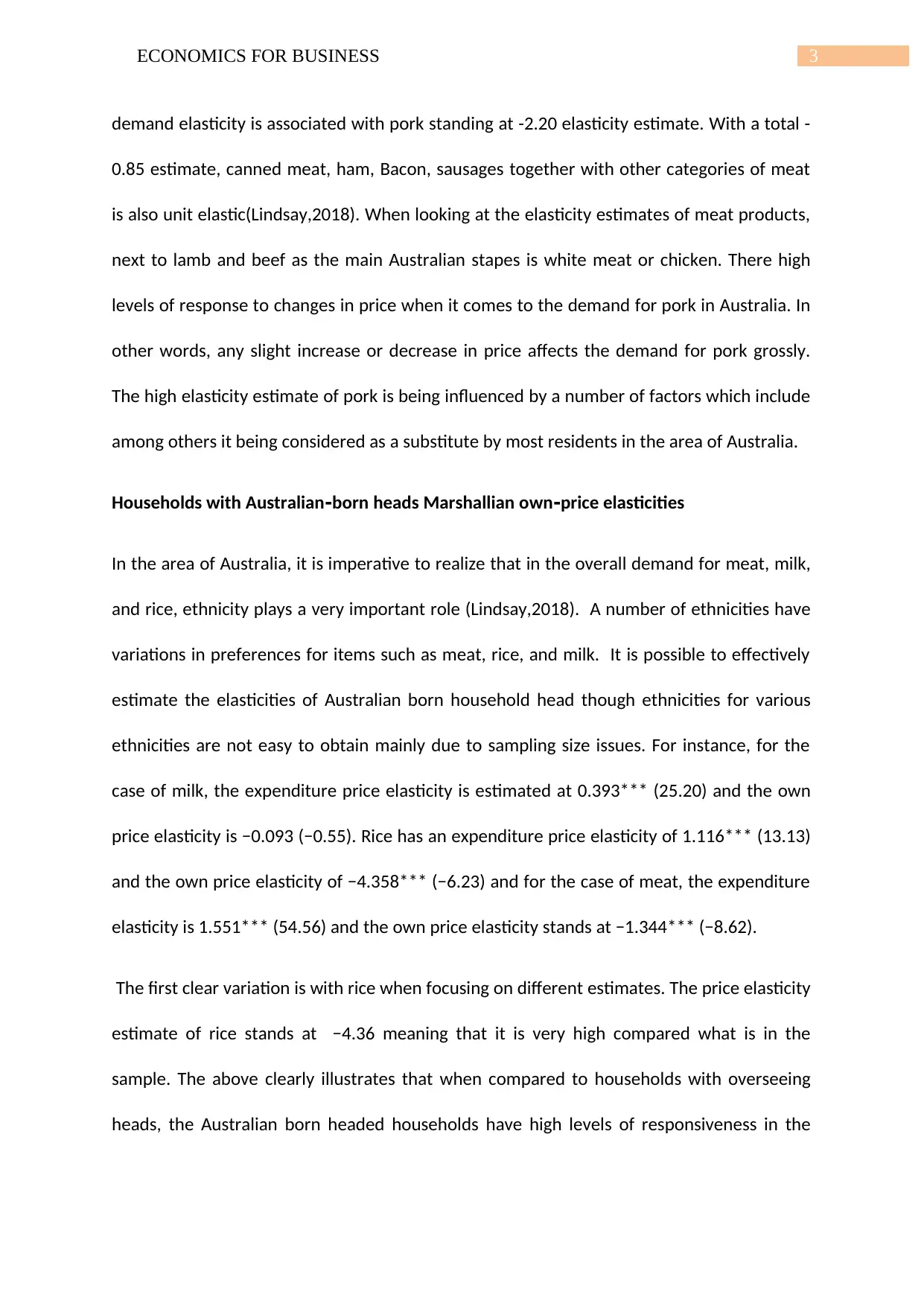
3ECONOMICS FOR BUSINESS
demand elasticity is associated with pork standing at -2.20 elasticity estimate. With a total -
0.85 estimate, canned meat, ham, Bacon, sausages together with other categories of meat
is also unit elastic(Lindsay,2018). When looking at the elasticity estimates of meat products,
next to lamb and beef as the main Australian stapes is white meat or chicken. There high
levels of response to changes in price when it comes to the demand for pork in Australia. In
other words, any slight increase or decrease in price affects the demand for pork grossly.
The high elasticity estimate of pork is being influenced by a number of factors which include
among others it being considered as a substitute by most residents in the area of Australia.
Households with Australian born heads Marshallian own price elasticities‐ ‐
In the area of Australia, it is imperative to realize that in the overall demand for meat, milk,
and rice, ethnicity plays a very important role (Lindsay,2018). A number of ethnicities have
variations in preferences for items such as meat, rice, and milk. It is possible to effectively
estimate the elasticities of Australian born household head though ethnicities for various
ethnicities are not easy to obtain mainly due to sampling size issues. For instance, for the
case of milk, the expenditure price elasticity is estimated at 0.393*** (25.20) and the own
price elasticity is −0.093 (−0.55). Rice has an expenditure price elasticity of 1.116*** (13.13)
and the own price elasticity of −4.358*** (−6.23) and for the case of meat, the expenditure
elasticity is 1.551*** (54.56) and the own price elasticity stands at −1.344*** (−8.62).
The first clear variation is with rice when focusing on different estimates. The price elasticity
estimate of rice stands at −4.36 meaning that it is very high compared what is in the
sample. The above clearly illustrates that when compared to households with overseeing
heads, the Australian born headed households have high levels of responsiveness in the
demand elasticity is associated with pork standing at -2.20 elasticity estimate. With a total -
0.85 estimate, canned meat, ham, Bacon, sausages together with other categories of meat
is also unit elastic(Lindsay,2018). When looking at the elasticity estimates of meat products,
next to lamb and beef as the main Australian stapes is white meat or chicken. There high
levels of response to changes in price when it comes to the demand for pork in Australia. In
other words, any slight increase or decrease in price affects the demand for pork grossly.
The high elasticity estimate of pork is being influenced by a number of factors which include
among others it being considered as a substitute by most residents in the area of Australia.
Households with Australian born heads Marshallian own price elasticities‐ ‐
In the area of Australia, it is imperative to realize that in the overall demand for meat, milk,
and rice, ethnicity plays a very important role (Lindsay,2018). A number of ethnicities have
variations in preferences for items such as meat, rice, and milk. It is possible to effectively
estimate the elasticities of Australian born household head though ethnicities for various
ethnicities are not easy to obtain mainly due to sampling size issues. For instance, for the
case of milk, the expenditure price elasticity is estimated at 0.393*** (25.20) and the own
price elasticity is −0.093 (−0.55). Rice has an expenditure price elasticity of 1.116*** (13.13)
and the own price elasticity of −4.358*** (−6.23) and for the case of meat, the expenditure
elasticity is 1.551*** (54.56) and the own price elasticity stands at −1.344*** (−8.62).
The first clear variation is with rice when focusing on different estimates. The price elasticity
estimate of rice stands at −4.36 meaning that it is very high compared what is in the
sample. The above clearly illustrates that when compared to households with overseeing
heads, the Australian born headed households have high levels of responsiveness in the
Paraphrase This Document
Need a fresh take? Get an instant paraphrase of this document with our AI Paraphraser
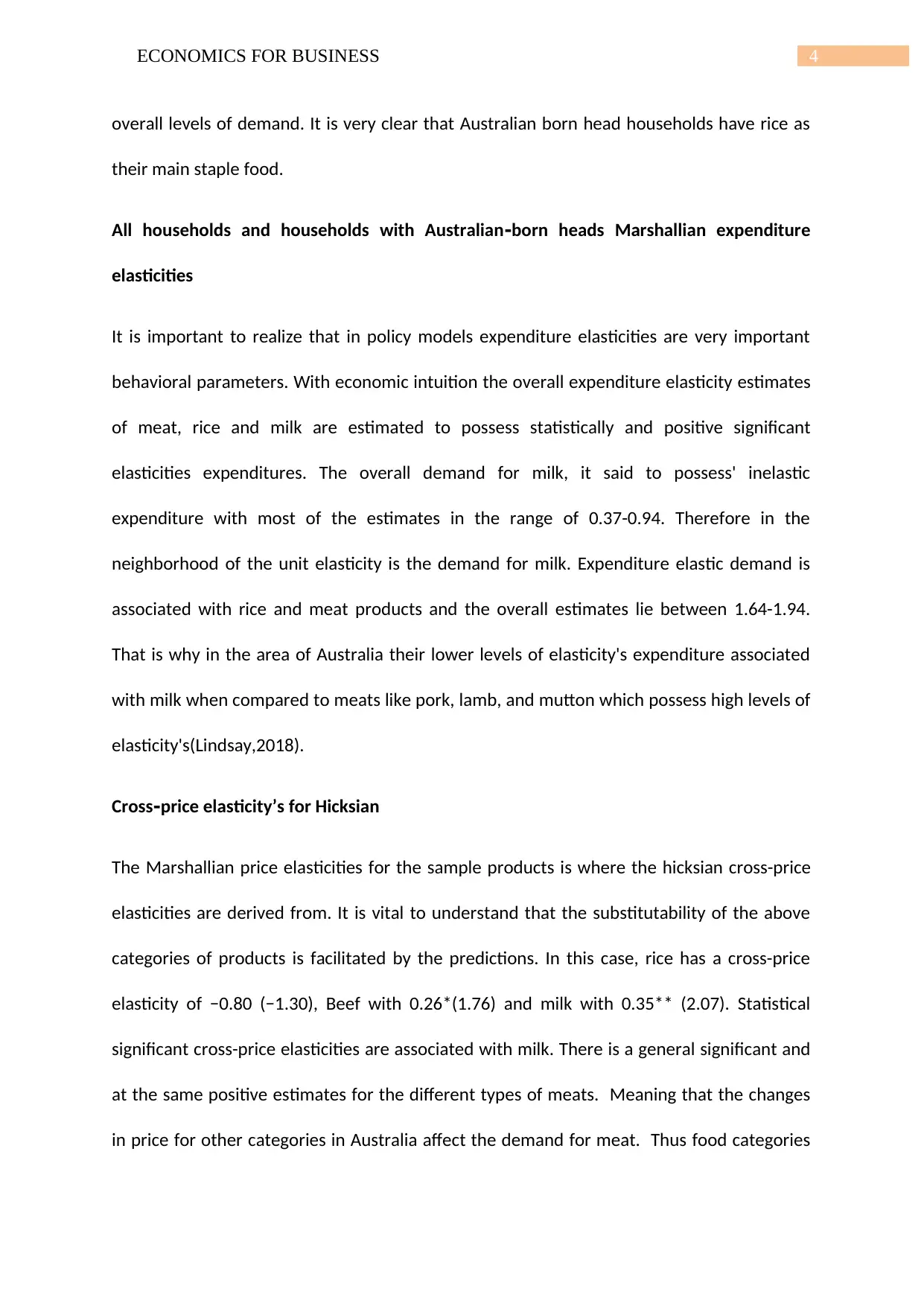
4ECONOMICS FOR BUSINESS
overall levels of demand. It is very clear that Australian born head households have rice as
their main staple food.
All households and households with Australian born heads Marshallian expenditure‐
elasticities
It is important to realize that in policy models expenditure elasticities are very important
behavioral parameters. With economic intuition the overall expenditure elasticity estimates
of meat, rice and milk are estimated to possess statistically and positive significant
elasticities expenditures. The overall demand for milk, it said to possess' inelastic
expenditure with most of the estimates in the range of 0.37-0.94. Therefore in the
neighborhood of the unit elasticity is the demand for milk. Expenditure elastic demand is
associated with rice and meat products and the overall estimates lie between 1.64-1.94.
That is why in the area of Australia their lower levels of elasticity's expenditure associated
with milk when compared to meats like pork, lamb, and mutton which possess high levels of
elasticity's(Lindsay,2018).
Cross price elasticity’s for Hicksian‐
The Marshallian price elasticities for the sample products is where the hicksian cross-price
elasticities are derived from. It is vital to understand that the substitutability of the above
categories of products is facilitated by the predictions. In this case, rice has a cross-price
elasticity of −0.80 (−1.30), Beef with 0.26*(1.76) and milk with 0.35** (2.07). Statistical
significant cross-price elasticities are associated with milk. There is a general significant and
at the same positive estimates for the different types of meats. Meaning that the changes
in price for other categories in Australia affect the demand for meat. Thus food categories
overall levels of demand. It is very clear that Australian born head households have rice as
their main staple food.
All households and households with Australian born heads Marshallian expenditure‐
elasticities
It is important to realize that in policy models expenditure elasticities are very important
behavioral parameters. With economic intuition the overall expenditure elasticity estimates
of meat, rice and milk are estimated to possess statistically and positive significant
elasticities expenditures. The overall demand for milk, it said to possess' inelastic
expenditure with most of the estimates in the range of 0.37-0.94. Therefore in the
neighborhood of the unit elasticity is the demand for milk. Expenditure elastic demand is
associated with rice and meat products and the overall estimates lie between 1.64-1.94.
That is why in the area of Australia their lower levels of elasticity's expenditure associated
with milk when compared to meats like pork, lamb, and mutton which possess high levels of
elasticity's(Lindsay,2018).
Cross price elasticity’s for Hicksian‐
The Marshallian price elasticities for the sample products is where the hicksian cross-price
elasticities are derived from. It is vital to understand that the substitutability of the above
categories of products is facilitated by the predictions. In this case, rice has a cross-price
elasticity of −0.80 (−1.30), Beef with 0.26*(1.76) and milk with 0.35** (2.07). Statistical
significant cross-price elasticities are associated with milk. There is a general significant and
at the same positive estimates for the different types of meats. Meaning that the changes
in price for other categories in Australia affect the demand for meat. Thus food categories
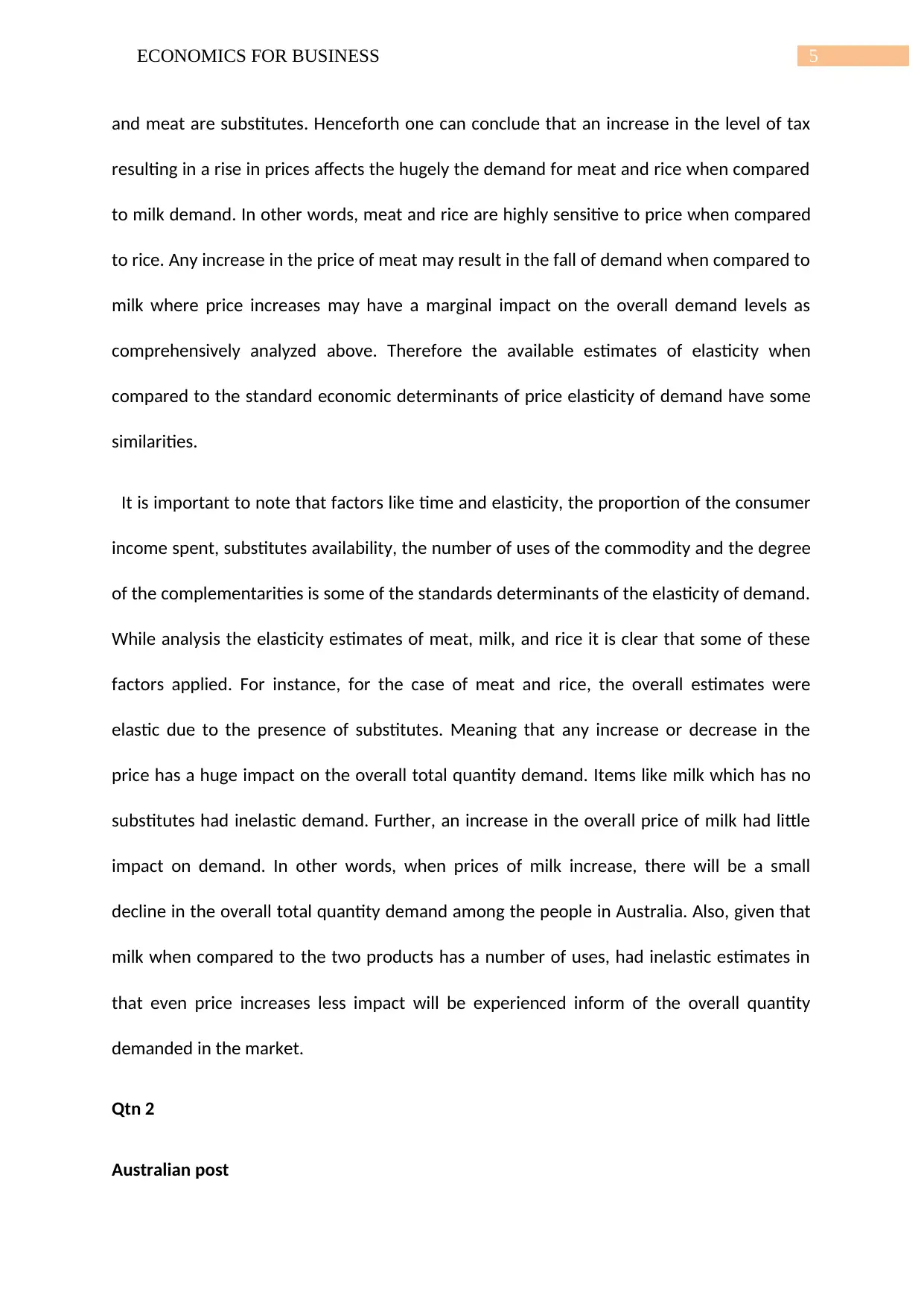
5ECONOMICS FOR BUSINESS
and meat are substitutes. Henceforth one can conclude that an increase in the level of tax
resulting in a rise in prices affects the hugely the demand for meat and rice when compared
to milk demand. In other words, meat and rice are highly sensitive to price when compared
to rice. Any increase in the price of meat may result in the fall of demand when compared to
milk where price increases may have a marginal impact on the overall demand levels as
comprehensively analyzed above. Therefore the available estimates of elasticity when
compared to the standard economic determinants of price elasticity of demand have some
similarities.
It is important to note that factors like time and elasticity, the proportion of the consumer
income spent, substitutes availability, the number of uses of the commodity and the degree
of the complementarities is some of the standards determinants of the elasticity of demand.
While analysis the elasticity estimates of meat, milk, and rice it is clear that some of these
factors applied. For instance, for the case of meat and rice, the overall estimates were
elastic due to the presence of substitutes. Meaning that any increase or decrease in the
price has a huge impact on the overall total quantity demand. Items like milk which has no
substitutes had inelastic demand. Further, an increase in the overall price of milk had little
impact on demand. In other words, when prices of milk increase, there will be a small
decline in the overall total quantity demand among the people in Australia. Also, given that
milk when compared to the two products has a number of uses, had inelastic estimates in
that even price increases less impact will be experienced inform of the overall quantity
demanded in the market.
Qtn 2
Australian post
and meat are substitutes. Henceforth one can conclude that an increase in the level of tax
resulting in a rise in prices affects the hugely the demand for meat and rice when compared
to milk demand. In other words, meat and rice are highly sensitive to price when compared
to rice. Any increase in the price of meat may result in the fall of demand when compared to
milk where price increases may have a marginal impact on the overall demand levels as
comprehensively analyzed above. Therefore the available estimates of elasticity when
compared to the standard economic determinants of price elasticity of demand have some
similarities.
It is important to note that factors like time and elasticity, the proportion of the consumer
income spent, substitutes availability, the number of uses of the commodity and the degree
of the complementarities is some of the standards determinants of the elasticity of demand.
While analysis the elasticity estimates of meat, milk, and rice it is clear that some of these
factors applied. For instance, for the case of meat and rice, the overall estimates were
elastic due to the presence of substitutes. Meaning that any increase or decrease in the
price has a huge impact on the overall total quantity demand. Items like milk which has no
substitutes had inelastic demand. Further, an increase in the overall price of milk had little
impact on demand. In other words, when prices of milk increase, there will be a small
decline in the overall total quantity demand among the people in Australia. Also, given that
milk when compared to the two products has a number of uses, had inelastic estimates in
that even price increases less impact will be experienced inform of the overall quantity
demanded in the market.
Qtn 2
Australian post
⊘ This is a preview!⊘
Do you want full access?
Subscribe today to unlock all pages.

Trusted by 1+ million students worldwide
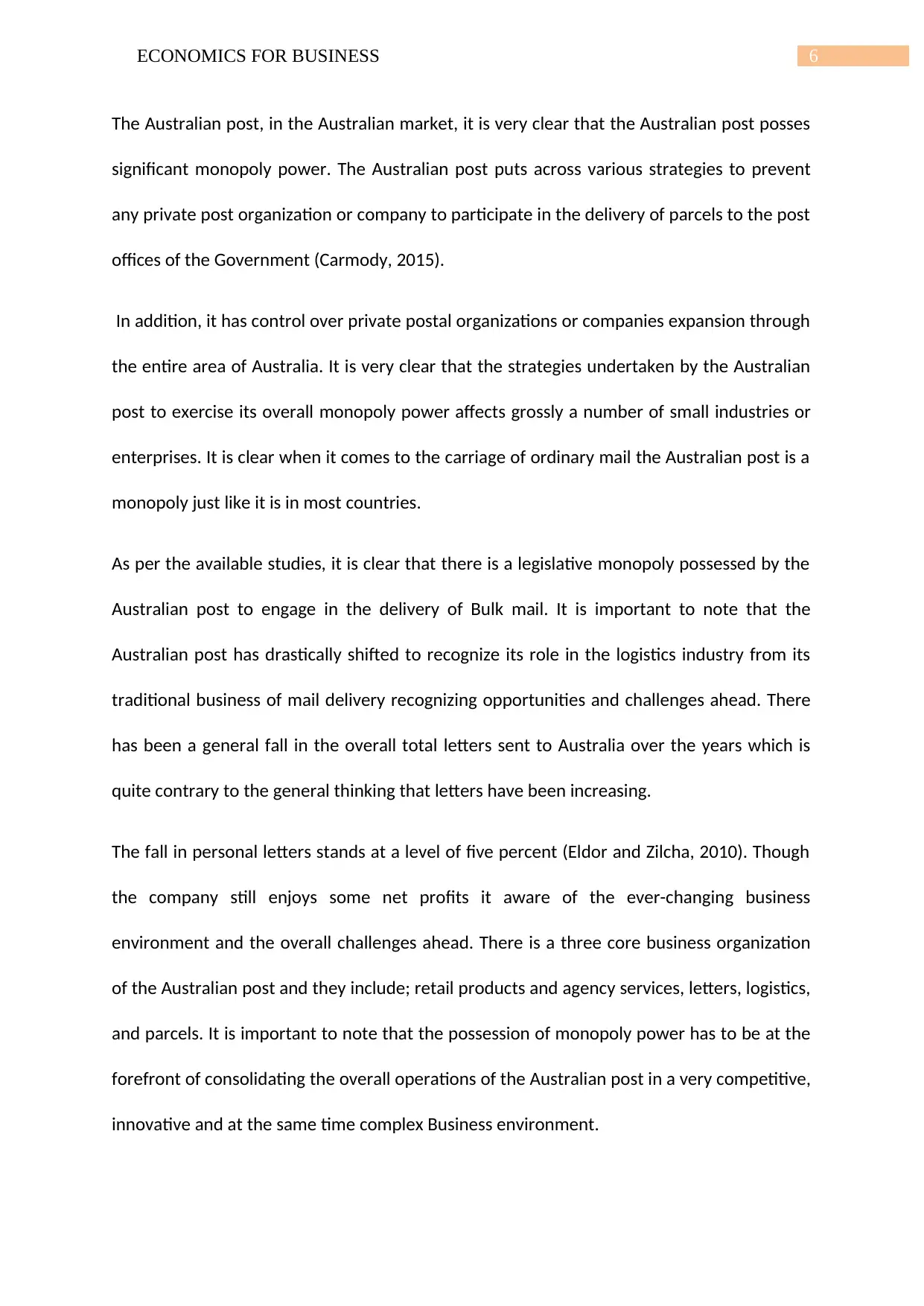
6ECONOMICS FOR BUSINESS
The Australian post, in the Australian market, it is very clear that the Australian post posses
significant monopoly power. The Australian post puts across various strategies to prevent
any private post organization or company to participate in the delivery of parcels to the post
offices of the Government (Carmody, 2015).
In addition, it has control over private postal organizations or companies expansion through
the entire area of Australia. It is very clear that the strategies undertaken by the Australian
post to exercise its overall monopoly power affects grossly a number of small industries or
enterprises. It is clear when it comes to the carriage of ordinary mail the Australian post is a
monopoly just like it is in most countries.
As per the available studies, it is clear that there is a legislative monopoly possessed by the
Australian post to engage in the delivery of Bulk mail. It is important to note that the
Australian post has drastically shifted to recognize its role in the logistics industry from its
traditional business of mail delivery recognizing opportunities and challenges ahead. There
has been a general fall in the overall total letters sent to Australia over the years which is
quite contrary to the general thinking that letters have been increasing.
The fall in personal letters stands at a level of five percent (Eldor and Zilcha, 2010). Though
the company still enjoys some net profits it aware of the ever-changing business
environment and the overall challenges ahead. There is a three core business organization
of the Australian post and they include; retail products and agency services, letters, logistics,
and parcels. It is important to note that the possession of monopoly power has to be at the
forefront of consolidating the overall operations of the Australian post in a very competitive,
innovative and at the same time complex Business environment.
The Australian post, in the Australian market, it is very clear that the Australian post posses
significant monopoly power. The Australian post puts across various strategies to prevent
any private post organization or company to participate in the delivery of parcels to the post
offices of the Government (Carmody, 2015).
In addition, it has control over private postal organizations or companies expansion through
the entire area of Australia. It is very clear that the strategies undertaken by the Australian
post to exercise its overall monopoly power affects grossly a number of small industries or
enterprises. It is clear when it comes to the carriage of ordinary mail the Australian post is a
monopoly just like it is in most countries.
As per the available studies, it is clear that there is a legislative monopoly possessed by the
Australian post to engage in the delivery of Bulk mail. It is important to note that the
Australian post has drastically shifted to recognize its role in the logistics industry from its
traditional business of mail delivery recognizing opportunities and challenges ahead. There
has been a general fall in the overall total letters sent to Australia over the years which is
quite contrary to the general thinking that letters have been increasing.
The fall in personal letters stands at a level of five percent (Eldor and Zilcha, 2010). Though
the company still enjoys some net profits it aware of the ever-changing business
environment and the overall challenges ahead. There is a three core business organization
of the Australian post and they include; retail products and agency services, letters, logistics,
and parcels. It is important to note that the possession of monopoly power has to be at the
forefront of consolidating the overall operations of the Australian post in a very competitive,
innovative and at the same time complex Business environment.
Paraphrase This Document
Need a fresh take? Get an instant paraphrase of this document with our AI Paraphraser
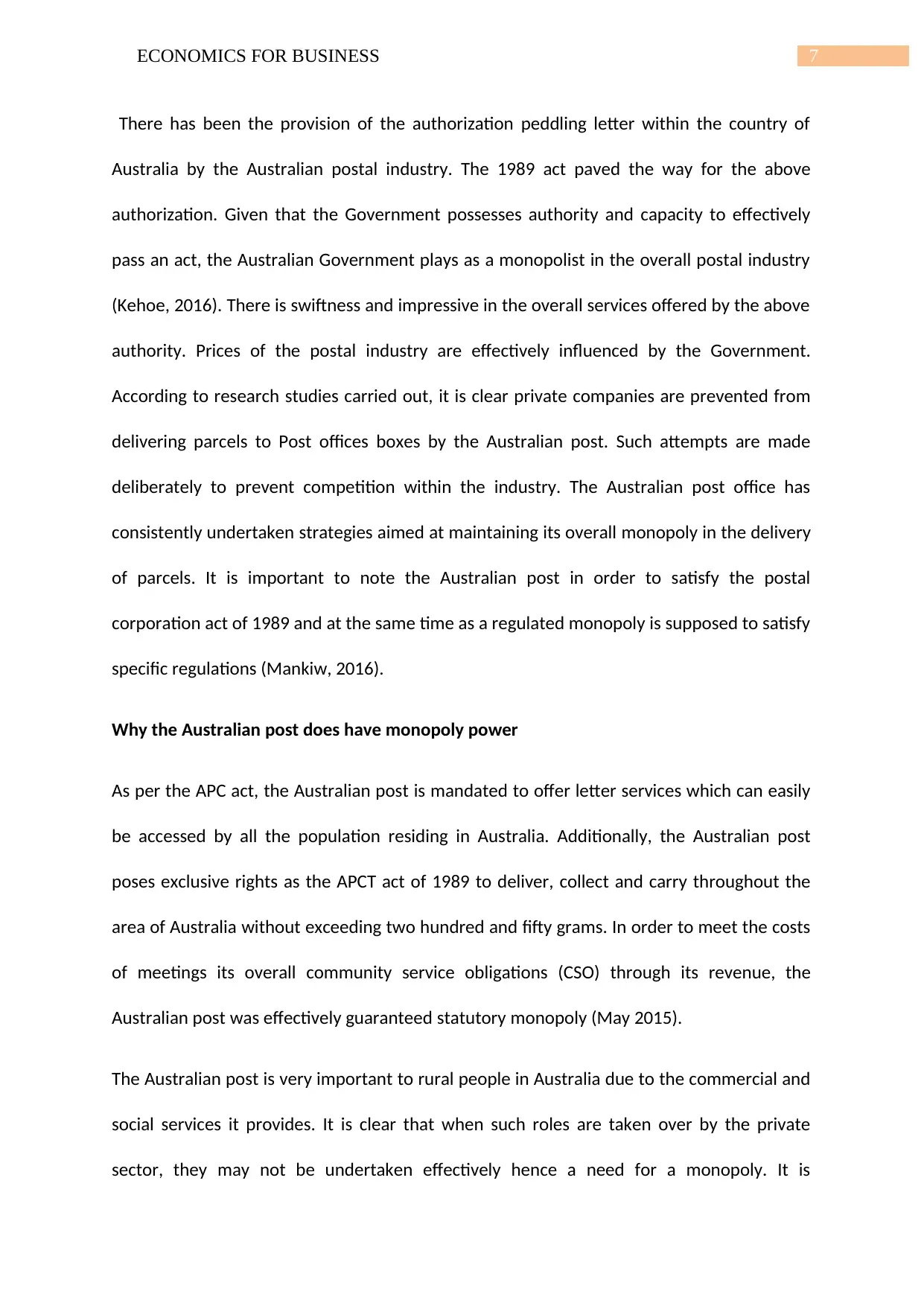
7ECONOMICS FOR BUSINESS
There has been the provision of the authorization peddling letter within the country of
Australia by the Australian postal industry. The 1989 act paved the way for the above
authorization. Given that the Government possesses authority and capacity to effectively
pass an act, the Australian Government plays as a monopolist in the overall postal industry
(Kehoe, 2016). There is swiftness and impressive in the overall services offered by the above
authority. Prices of the postal industry are effectively influenced by the Government.
According to research studies carried out, it is clear private companies are prevented from
delivering parcels to Post offices boxes by the Australian post. Such attempts are made
deliberately to prevent competition within the industry. The Australian post office has
consistently undertaken strategies aimed at maintaining its overall monopoly in the delivery
of parcels. It is important to note the Australian post in order to satisfy the postal
corporation act of 1989 and at the same time as a regulated monopoly is supposed to satisfy
specific regulations (Mankiw, 2016).
Why the Australian post does have monopoly power
As per the APC act, the Australian post is mandated to offer letter services which can easily
be accessed by all the population residing in Australia. Additionally, the Australian post
poses exclusive rights as the APCT act of 1989 to deliver, collect and carry throughout the
area of Australia without exceeding two hundred and fifty grams. In order to meet the costs
of meetings its overall community service obligations (CSO) through its revenue, the
Australian post was effectively guaranteed statutory monopoly (May 2015).
The Australian post is very important to rural people in Australia due to the commercial and
social services it provides. It is clear that when such roles are taken over by the private
sector, they may not be undertaken effectively hence a need for a monopoly. It is
There has been the provision of the authorization peddling letter within the country of
Australia by the Australian postal industry. The 1989 act paved the way for the above
authorization. Given that the Government possesses authority and capacity to effectively
pass an act, the Australian Government plays as a monopolist in the overall postal industry
(Kehoe, 2016). There is swiftness and impressive in the overall services offered by the above
authority. Prices of the postal industry are effectively influenced by the Government.
According to research studies carried out, it is clear private companies are prevented from
delivering parcels to Post offices boxes by the Australian post. Such attempts are made
deliberately to prevent competition within the industry. The Australian post office has
consistently undertaken strategies aimed at maintaining its overall monopoly in the delivery
of parcels. It is important to note the Australian post in order to satisfy the postal
corporation act of 1989 and at the same time as a regulated monopoly is supposed to satisfy
specific regulations (Mankiw, 2016).
Why the Australian post does have monopoly power
As per the APC act, the Australian post is mandated to offer letter services which can easily
be accessed by all the population residing in Australia. Additionally, the Australian post
poses exclusive rights as the APCT act of 1989 to deliver, collect and carry throughout the
area of Australia without exceeding two hundred and fifty grams. In order to meet the costs
of meetings its overall community service obligations (CSO) through its revenue, the
Australian post was effectively guaranteed statutory monopoly (May 2015).
The Australian post is very important to rural people in Australia due to the commercial and
social services it provides. It is clear that when such roles are taken over by the private
sector, they may not be undertaken effectively hence a need for a monopoly. It is
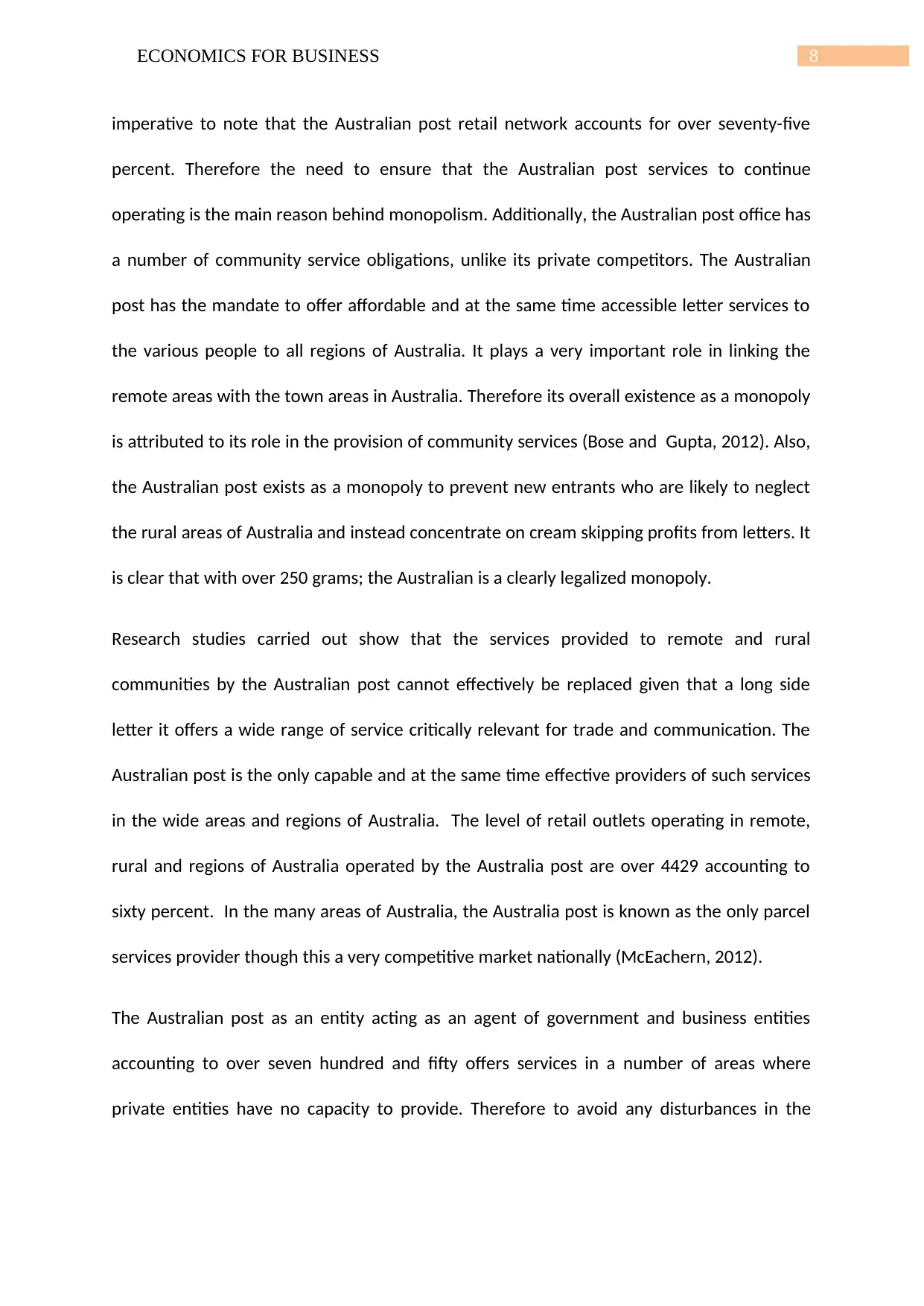
8ECONOMICS FOR BUSINESS
imperative to note that the Australian post retail network accounts for over seventy-five
percent. Therefore the need to ensure that the Australian post services to continue
operating is the main reason behind monopolism. Additionally, the Australian post office has
a number of community service obligations, unlike its private competitors. The Australian
post has the mandate to offer affordable and at the same time accessible letter services to
the various people to all regions of Australia. It plays a very important role in linking the
remote areas with the town areas in Australia. Therefore its overall existence as a monopoly
is attributed to its role in the provision of community services (Bose and Gupta, 2012). Also,
the Australian post exists as a monopoly to prevent new entrants who are likely to neglect
the rural areas of Australia and instead concentrate on cream skipping profits from letters. It
is clear that with over 250 grams; the Australian is a clearly legalized monopoly.
Research studies carried out show that the services provided to remote and rural
communities by the Australian post cannot effectively be replaced given that a long side
letter it offers a wide range of service critically relevant for trade and communication. The
Australian post is the only capable and at the same time effective providers of such services
in the wide areas and regions of Australia. The level of retail outlets operating in remote,
rural and regions of Australia operated by the Australia post are over 4429 accounting to
sixty percent. In the many areas of Australia, the Australia post is known as the only parcel
services provider though this a very competitive market nationally (McEachern, 2012).
The Australian post as an entity acting as an agent of government and business entities
accounting to over seven hundred and fifty offers services in a number of areas where
private entities have no capacity to provide. Therefore to avoid any disturbances in the
imperative to note that the Australian post retail network accounts for over seventy-five
percent. Therefore the need to ensure that the Australian post services to continue
operating is the main reason behind monopolism. Additionally, the Australian post office has
a number of community service obligations, unlike its private competitors. The Australian
post has the mandate to offer affordable and at the same time accessible letter services to
the various people to all regions of Australia. It plays a very important role in linking the
remote areas with the town areas in Australia. Therefore its overall existence as a monopoly
is attributed to its role in the provision of community services (Bose and Gupta, 2012). Also,
the Australian post exists as a monopoly to prevent new entrants who are likely to neglect
the rural areas of Australia and instead concentrate on cream skipping profits from letters. It
is clear that with over 250 grams; the Australian is a clearly legalized monopoly.
Research studies carried out show that the services provided to remote and rural
communities by the Australian post cannot effectively be replaced given that a long side
letter it offers a wide range of service critically relevant for trade and communication. The
Australian post is the only capable and at the same time effective providers of such services
in the wide areas and regions of Australia. The level of retail outlets operating in remote,
rural and regions of Australia operated by the Australia post are over 4429 accounting to
sixty percent. In the many areas of Australia, the Australia post is known as the only parcel
services provider though this a very competitive market nationally (McEachern, 2012).
The Australian post as an entity acting as an agent of government and business entities
accounting to over seven hundred and fifty offers services in a number of areas where
private entities have no capacity to provide. Therefore to avoid any disturbances in the
⊘ This is a preview!⊘
Do you want full access?
Subscribe today to unlock all pages.

Trusted by 1+ million students worldwide
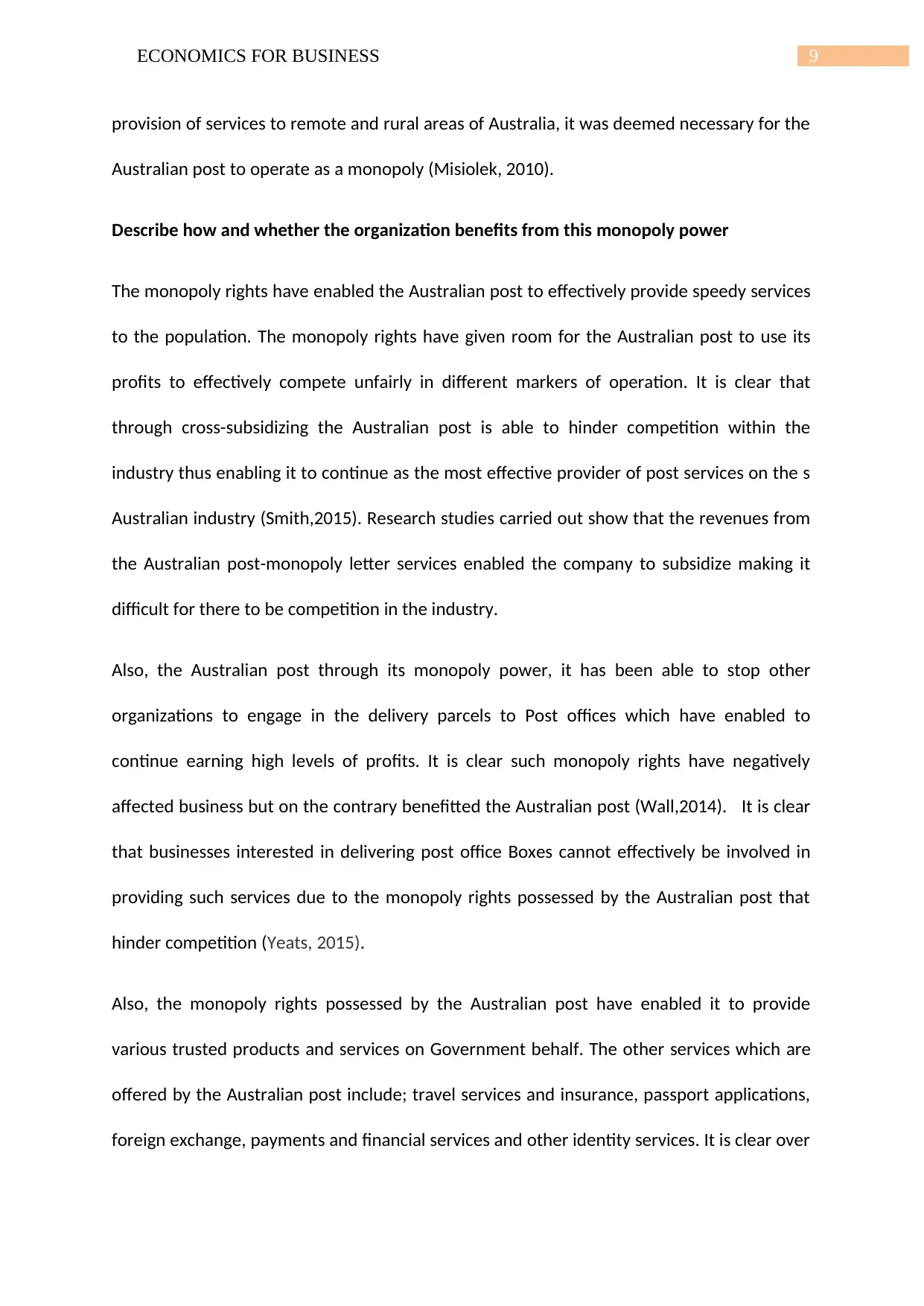
9ECONOMICS FOR BUSINESS
provision of services to remote and rural areas of Australia, it was deemed necessary for the
Australian post to operate as a monopoly (Misiolek, 2010).
Describe how and whether the organization benefits from this monopoly power
The monopoly rights have enabled the Australian post to effectively provide speedy services
to the population. The monopoly rights have given room for the Australian post to use its
profits to effectively compete unfairly in different markers of operation. It is clear that
through cross-subsidizing the Australian post is able to hinder competition within the
industry thus enabling it to continue as the most effective provider of post services on the s
Australian industry (Smith,2015). Research studies carried out show that the revenues from
the Australian post-monopoly letter services enabled the company to subsidize making it
difficult for there to be competition in the industry.
Also, the Australian post through its monopoly power, it has been able to stop other
organizations to engage in the delivery parcels to Post offices which have enabled to
continue earning high levels of profits. It is clear such monopoly rights have negatively
affected business but on the contrary benefitted the Australian post (Wall,2014). It is clear
that businesses interested in delivering post office Boxes cannot effectively be involved in
providing such services due to the monopoly rights possessed by the Australian post that
hinder competition (Yeats, 2015).
Also, the monopoly rights possessed by the Australian post have enabled it to provide
various trusted products and services on Government behalf. The other services which are
offered by the Australian post include; travel services and insurance, passport applications,
foreign exchange, payments and financial services and other identity services. It is clear over
provision of services to remote and rural areas of Australia, it was deemed necessary for the
Australian post to operate as a monopoly (Misiolek, 2010).
Describe how and whether the organization benefits from this monopoly power
The monopoly rights have enabled the Australian post to effectively provide speedy services
to the population. The monopoly rights have given room for the Australian post to use its
profits to effectively compete unfairly in different markers of operation. It is clear that
through cross-subsidizing the Australian post is able to hinder competition within the
industry thus enabling it to continue as the most effective provider of post services on the s
Australian industry (Smith,2015). Research studies carried out show that the revenues from
the Australian post-monopoly letter services enabled the company to subsidize making it
difficult for there to be competition in the industry.
Also, the Australian post through its monopoly power, it has been able to stop other
organizations to engage in the delivery parcels to Post offices which have enabled to
continue earning high levels of profits. It is clear such monopoly rights have negatively
affected business but on the contrary benefitted the Australian post (Wall,2014). It is clear
that businesses interested in delivering post office Boxes cannot effectively be involved in
providing such services due to the monopoly rights possessed by the Australian post that
hinder competition (Yeats, 2015).
Also, the monopoly rights possessed by the Australian post have enabled it to provide
various trusted products and services on Government behalf. The other services which are
offered by the Australian post include; travel services and insurance, passport applications,
foreign exchange, payments and financial services and other identity services. It is clear over
Paraphrase This Document
Need a fresh take? Get an instant paraphrase of this document with our AI Paraphraser
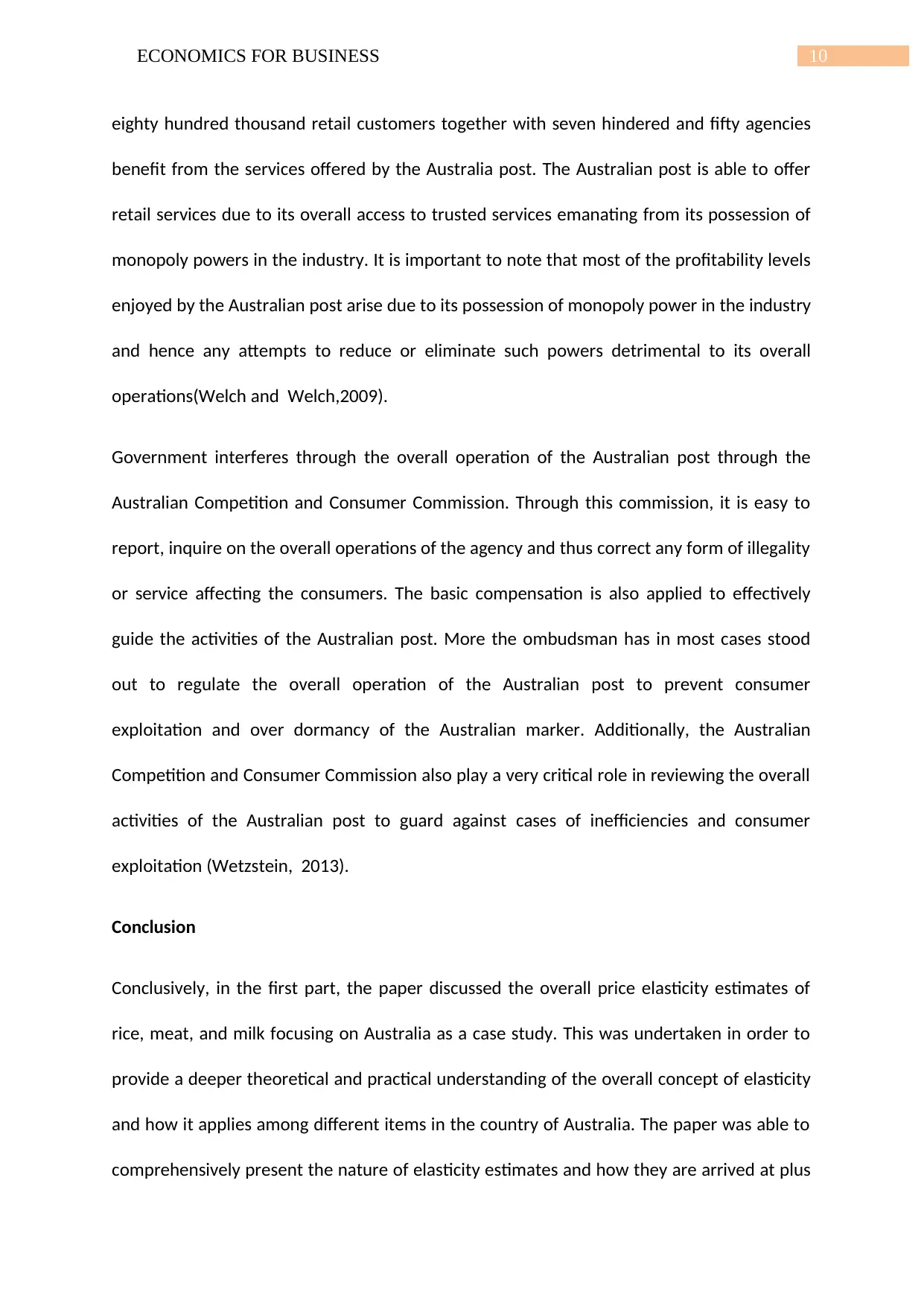
10ECONOMICS FOR BUSINESS
eighty hundred thousand retail customers together with seven hindered and fifty agencies
benefit from the services offered by the Australia post. The Australian post is able to offer
retail services due to its overall access to trusted services emanating from its possession of
monopoly powers in the industry. It is important to note that most of the profitability levels
enjoyed by the Australian post arise due to its possession of monopoly power in the industry
and hence any attempts to reduce or eliminate such powers detrimental to its overall
operations(Welch and Welch,2009).
Government interferes through the overall operation of the Australian post through the
Australian Competition and Consumer Commission. Through this commission, it is easy to
report, inquire on the overall operations of the agency and thus correct any form of illegality
or service affecting the consumers. The basic compensation is also applied to effectively
guide the activities of the Australian post. More the ombudsman has in most cases stood
out to regulate the overall operation of the Australian post to prevent consumer
exploitation and over dormancy of the Australian marker. Additionally, the Australian
Competition and Consumer Commission also play a very critical role in reviewing the overall
activities of the Australian post to guard against cases of inefficiencies and consumer
exploitation (Wetzstein, 2013).
Conclusion
Conclusively, in the first part, the paper discussed the overall price elasticity estimates of
rice, meat, and milk focusing on Australia as a case study. This was undertaken in order to
provide a deeper theoretical and practical understanding of the overall concept of elasticity
and how it applies among different items in the country of Australia. The paper was able to
comprehensively present the nature of elasticity estimates and how they are arrived at plus
eighty hundred thousand retail customers together with seven hindered and fifty agencies
benefit from the services offered by the Australia post. The Australian post is able to offer
retail services due to its overall access to trusted services emanating from its possession of
monopoly powers in the industry. It is important to note that most of the profitability levels
enjoyed by the Australian post arise due to its possession of monopoly power in the industry
and hence any attempts to reduce or eliminate such powers detrimental to its overall
operations(Welch and Welch,2009).
Government interferes through the overall operation of the Australian post through the
Australian Competition and Consumer Commission. Through this commission, it is easy to
report, inquire on the overall operations of the agency and thus correct any form of illegality
or service affecting the consumers. The basic compensation is also applied to effectively
guide the activities of the Australian post. More the ombudsman has in most cases stood
out to regulate the overall operation of the Australian post to prevent consumer
exploitation and over dormancy of the Australian marker. Additionally, the Australian
Competition and Consumer Commission also play a very critical role in reviewing the overall
activities of the Australian post to guard against cases of inefficiencies and consumer
exploitation (Wetzstein, 2013).
Conclusion
Conclusively, in the first part, the paper discussed the overall price elasticity estimates of
rice, meat, and milk focusing on Australia as a case study. This was undertaken in order to
provide a deeper theoretical and practical understanding of the overall concept of elasticity
and how it applies among different items in the country of Australia. The paper was able to
comprehensively present the nature of elasticity estimates and how they are arrived at plus
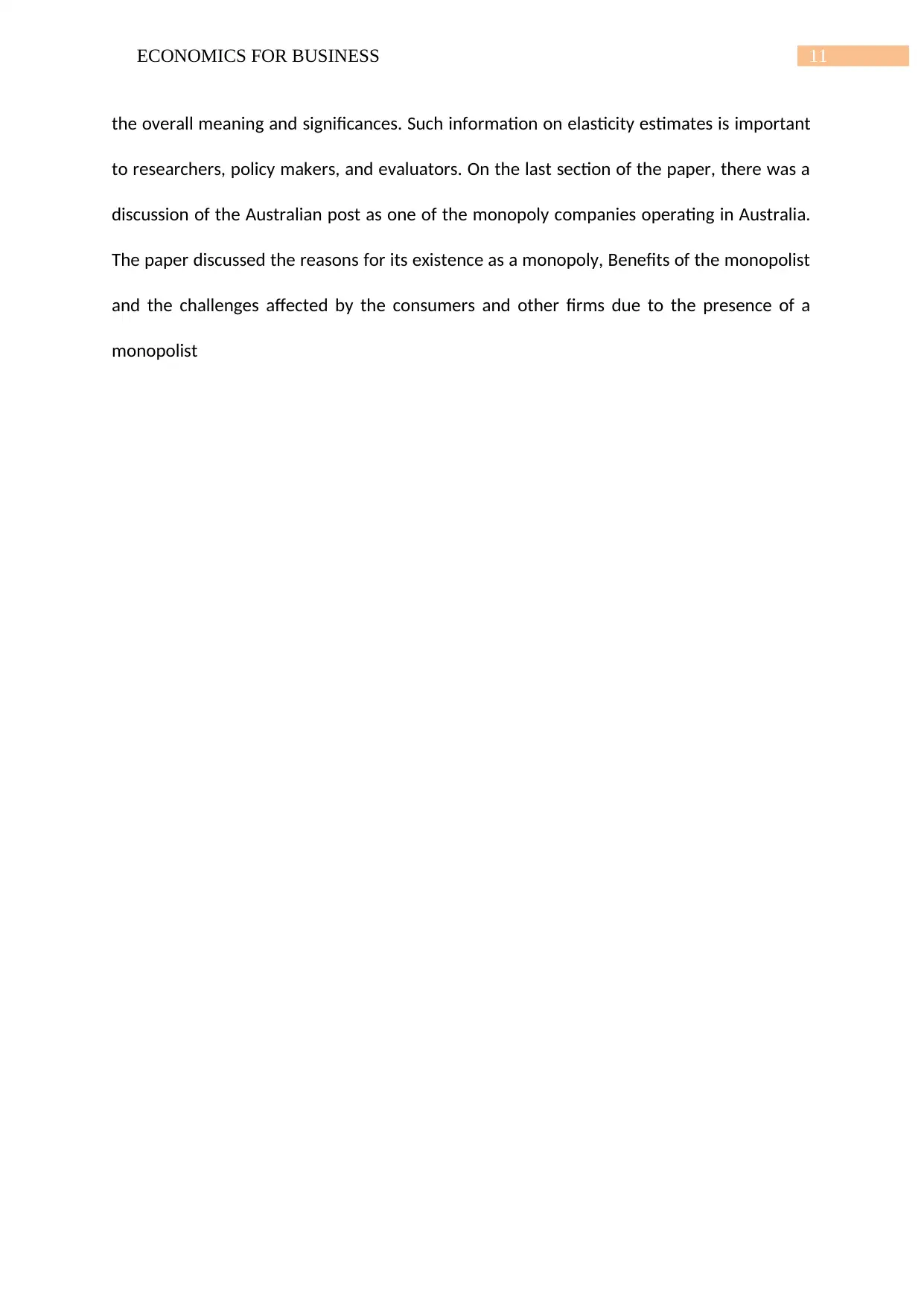
11ECONOMICS FOR BUSINESS
the overall meaning and significances. Such information on elasticity estimates is important
to researchers, policy makers, and evaluators. On the last section of the paper, there was a
discussion of the Australian post as one of the monopoly companies operating in Australia.
The paper discussed the reasons for its existence as a monopoly, Benefits of the monopolist
and the challenges affected by the consumers and other firms due to the presence of a
monopolist
the overall meaning and significances. Such information on elasticity estimates is important
to researchers, policy makers, and evaluators. On the last section of the paper, there was a
discussion of the Australian post as one of the monopoly companies operating in Australia.
The paper discussed the reasons for its existence as a monopoly, Benefits of the monopolist
and the challenges affected by the consumers and other firms due to the presence of a
monopolist
⊘ This is a preview!⊘
Do you want full access?
Subscribe today to unlock all pages.

Trusted by 1+ million students worldwide
1 out of 15
Related Documents
Your All-in-One AI-Powered Toolkit for Academic Success.
+13062052269
info@desklib.com
Available 24*7 on WhatsApp / Email
![[object Object]](/_next/static/media/star-bottom.7253800d.svg)
Unlock your academic potential
Copyright © 2020–2026 A2Z Services. All Rights Reserved. Developed and managed by ZUCOL.



